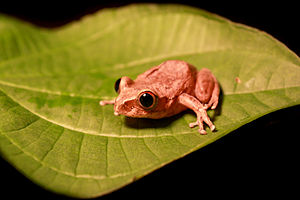Gabon forest climber frog
| Gabon forest climber frog | ||||||||||||
|---|---|---|---|---|---|---|---|---|---|---|---|---|

Gabon forest climber frog ( Leptopelis aubryi ) |
||||||||||||
| Systematics | ||||||||||||
|
||||||||||||
| Scientific name | ||||||||||||
| Leptopelis aubryi | ||||||||||||
| ( Duméril , 1856) |
The Gabon forest climber frog ( Leptopelis aubryi ) is a frog from the genus of the forest climber frog in the family of long finger frogs (Arthroleptidae). It is common in western and south-western Africa.
description
Gabon forest climber frog is one of the rather small species of forest climber frog. The males are 33 to 39 millimeters long, the females 44 to 54 millimeters. The species is brown in color and can be slightly marbled on the back. The iris is colored red or orange. Small black spots can be seen on the flanks, especially in the groin area. Small white spots are often found on the back and on the limbs. The webbed feet on the fore and hind limbs are moderately pronounced, similar to Leptopelis ocellatus , but weaker than Leptopelis viridis . Many species and color variants of the forest climber frogs look like Leptopelis aubryi .
distribution
The distribution area stretches from southeast Nigeria through southern Cameroon and the Central African Republic , to Equatorial Guinea , Gabon , the Republic of the Congo and the Democratic Republic of the Congo . The species is also known from the Angolan enclave of Cabinda . Reports of occurrence at Dundo in the far northeast of Angola have not been definitively confirmed. Specimens found on the island of Bioko are more likely to belong to the species Leptopelis modestus . There are reports of West African occurrences in Ghana and Sierra Leone . However, these belong to the very similar species Leptopelis spiritusnoctis , described in 2007 , from which Leptopelis aubryi also differs in the nature of its vocalizations.
Habitat and way of life
The species occurs in tropical and subtropical climates. It is ecologically very adaptable and lives on trees and bushes in the lowlands, also in broken and secondary forests , in degraded plantations and outside of forests. There it occurs on seasonally moist or flooded savannas , marsh meadows, on former farmland and in gardens.
The males call from lower branches that are located at a height of half a meter to one and a half meters. Your reputation is a simple click that to a flick reminds her tongue. You can also produce a short series of such sounds, which then sound like castanets . The eggs are laid in a nest dug in the damp ground, where the larvae hatch. These tadpoles then continue to develop in nearby swamps or ponds.
Individual evidence
- ↑ a b c Leptopelis aubryi in Amphibiaweb
- ↑ a b c Leptopelis aubryi in the Red List of Threatened Species of the IUCN 2013. Posted by: Arne Schiøtz, J.-L. Amiet, M. Burger & R. Drewes, 2013. Retrieved May 9, 2014.
- ↑ Darrel Frost: Leptopelis aubryi , Amphibian Species of the World, Version 6.0, American Museum of Natural History, 1998-2014, accessed May 9, 2014
literature
- Auguste Duméril : Note sur les reptiles du Gabon . Revue et Magasin de Zoologie Pure et Appliquée, Paris, ser. 2, vol. 8, pp. 369-562, 1859 ( original )
Web links
- Darrel Frost: Leptopelis aubryi , Amphibian Species of the World, Version 6.0, American Museum of Natural History, 1998-2014, accessed May 9, 2014
- Leptopelis aubryi at Amphibiaweb (Engl.)
- Leptopelis aubryi in the endangered Red List species the IUCN 2013 Posted by: Arne Schiøtz, J.-L. Amiet, M. Burger & R. Drewes, 2013. Retrieved May 9, 2014.